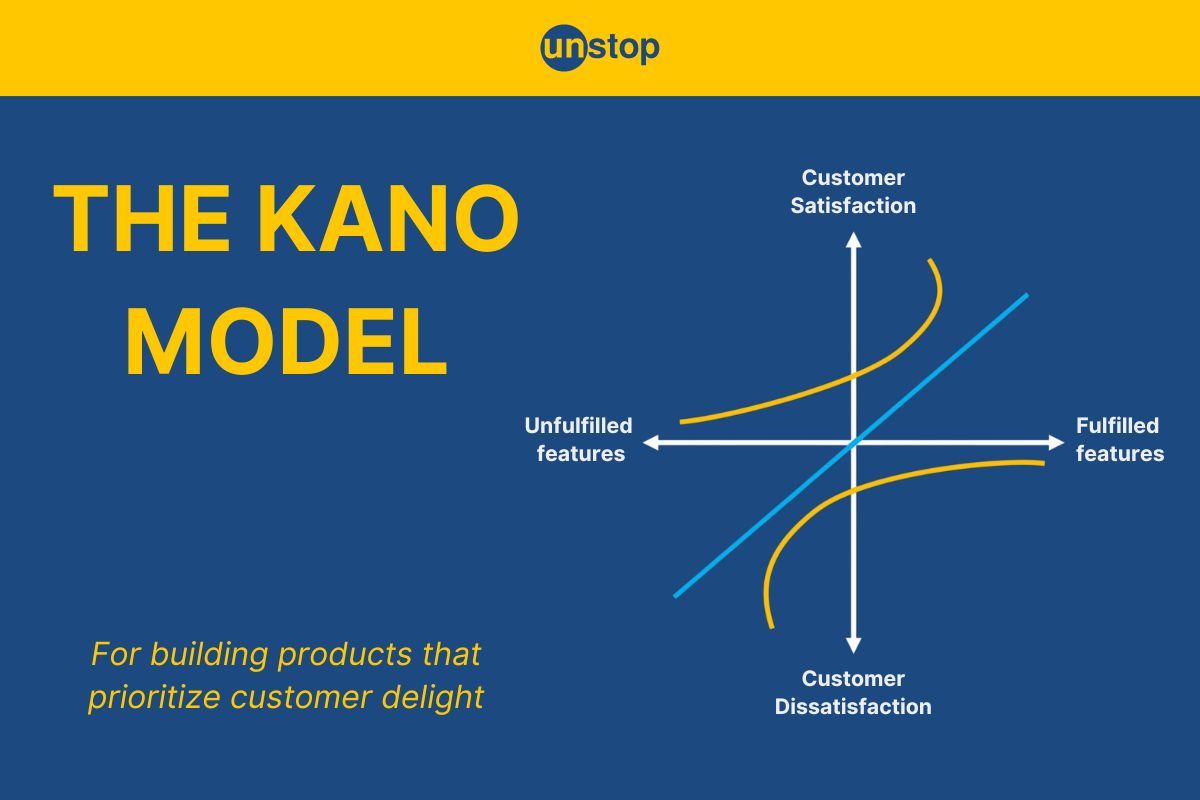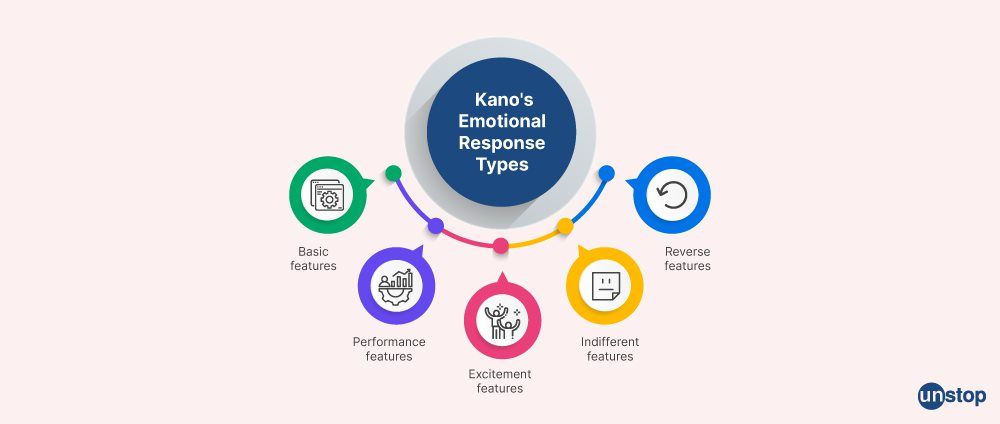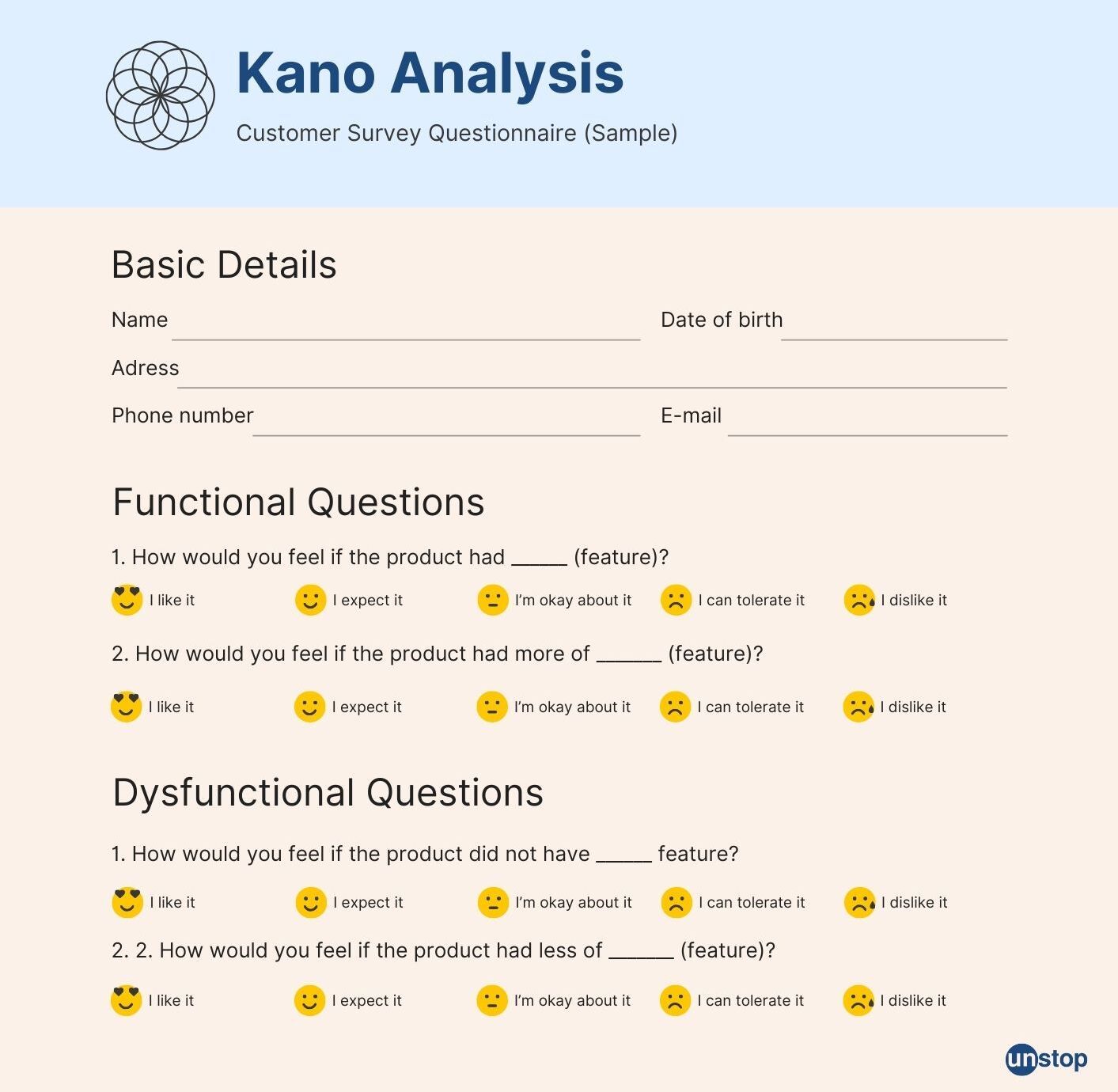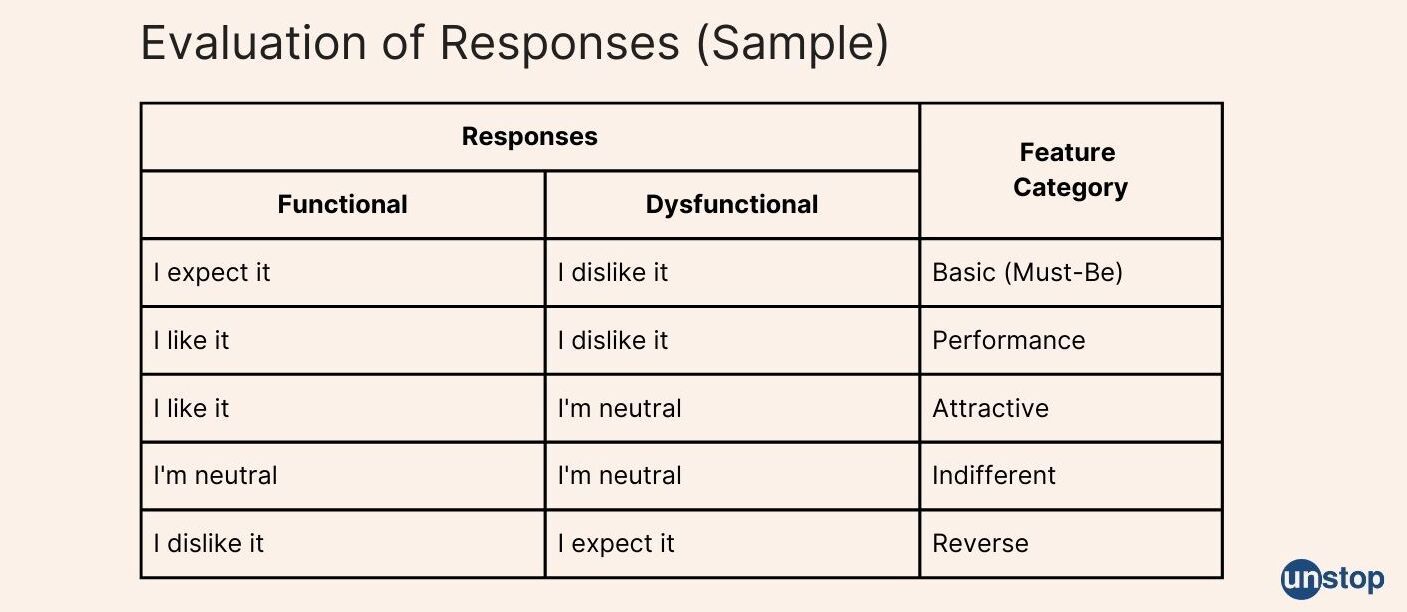- How Does The Kano Model Work?
- Kano Model: When To Use?
- Limitations Of The Kano Model
- Closing Thoughts
- Frequently Asked Questions (FAQs)
Kano Model Explained (With Example): Know Steps, Advantages & Limitations

How often have you heard the phrase, "customer is king"? Too many times to count, right? Yet, it continues to be a guiding principle for businesses. Why? Because businesses are always trying to create dramatic customer delight. In its most basic sense, the Kano Model helps create this delight.
The first step in achieving customer delight is recognizing customer requirements. It's how businesses ensure brand loyalty and gain profits. It's why they keep innovating—to meet customer expectations! And it's why the Kano Model is so important—because, at its core, it's an analysis tool based on customer emotions.
But what is the Kano Model? Read ahead to find out.
What Is Kano Model?

Creating a product roadmap is a key process in product management. It's how product managers translate the product vision and strategy into a visual communication tool - to be shared with all stakeholders.
Kano Model (pronounced “Kah-No”) is a way of prioritizing features on a product roadmap. It is an approach or technique that helps product managers determine which features to include in a product or service. The criteria for including and excluding a feature are simple: its impact on customer satisfaction.
To sum it up, the Kano Model focuses on product features that can help realize customer requirements and enhance customer satisfaction.
Who uses the Kano Model?: Most commonly, the product manager or the product team usually uses the Kano model, ideally during product development, to determine the features to be included in a product. However, it may even be used by marketing team.
Benefits Of The Kano Model
Models like the Kano Model are excellent prioritization tools, especially when there are tight deadlines and/or limited resources. As they allow product teams to make efficient decisions in a limited time. Here's a look at some of its key benefits:
- Saves time and money: The model helps save time and money because it only focuses on customer tastes, i.e., feature options that enhance customer happiness. Thus, the Kano Model helps eliminate those ideas for features that may leave customers dissatisfied, saving an organization's time and effort in building and testing such features.
- Helps prioritize key features: By dividing features into categories, the model helps prioritize high-satisfaction features. Such feature insights enable the product team to focus on the most important feature requirements first.
- Focus on customer desires: It goes without saying that the model's focus on the desires of customers is its biggest strength. Whether the idea is to improve current features, introduce crucial features, or eliminate dissatisfier features, the guiding principle remains the same - customer satisfaction.
Ultimately, the Kano Model helps product managers make the connection between customer satisfaction and the realization of customer requirements and is an important tool in product management.
History Of The Kano Model
The Kano Model was created by Dr. Noriaki Kano in 1984. Dr. Kano was a professor of quality management at the Tokyo University of Science, researching ways to improve customer satisfaction and loyalty. At the time, the accepted approaches to increasing customer satisfaction levels were processing complaints and enhancing popular features.
Dr. Kano wanted to understand if there were other features that could help maintain or improve the customers’ brand loyalty. To do so, he conducted a study with 900 participants. Using the results from the study, Dr. Kano developed the original Kano reaction graph. Through his study, Dr. Kano came up with a list of features or emotional response types to product features.
Kano Model: Customer Reaction Types

When introducing new features into a product or service, product managers take into account the potential customer reactions.
As per the Kano Model, these reactions can be divided into five types depending upon a customer's satisfaction levels. These feature categories (also referred to as attributes) are:
Basic features
These are the must-have features that a customer expects from any product or service. They're also referred to as threshold attributes. As the name suggests, these features perform the basic function of a product or service, thereby meeting customer assumptions.
For example, even though smartphones have become the norm, the basic function of a mobile phone remains communication via phone calls. If this basic function isn't met, the mobile is as good as its now-defunct predecessor, the beeper or pager. A lack of basic attributes can lead to customer dissatisfaction as the essential needs are not being met.
Performance features
Performance attributes or features are elements that enhance customer delight. A greater number of performance features directly improve customer satisfaction, such as a mobile phone with large storage, faster charging capabilities, and excellent camera facilities.
Performance attributes are essential to compete with the competition in the market, especially in categories with intense competition. They also help improve customer loyalty levels.
Excitement Features
Also known as 'attractive features,' this category refers to the "wow" element in a product or service. As the name suggests, these are the features that excite customers. Excitement attributes are unexpected features that customers don't expect from a product or service, but that significantly enhance customer satisfaction.
For example, a mobile phone that allows for seamless voice-to-text translation. To quote a real-life example, when Apple first introduced the virtual assistant SIRI, it was akin to an exciting feature.
Excitement or attractive features like these can significantly increase customer expectations because they surpass customer assumptions about the product or service.
Indifferent features
Indifferent attributes or features evoke no reaction from customers. While these features may not necessarily detract from the overall functionality of the phone, they are considered indifferent because they do not significantly impact the user experience. These are features that product managers can ignore or remove in favour of incorporating performance features.
These features have indifferent qualities because removing them would not impact customer satisfaction levels in any manner. Customers are usually neutral about their existence.
For example, a pre-installed app that is rarely used or not essential to the user. This could include apps for specific services or games that the user has no interest in.
Reverse features
Reverse attributes or features are features that can reverse customer satisfaction, i.e., lead to customer dissatisfaction. For example, an app that has a clunky user interface that makes it difficult to navigate the content on the site. This may cause customers to switch to competitors or even delete the app altogether. Because it's a hassle to use it, any associated benefits it may have are ignored.
Reverse features can cause customers to be dissatisfied as they fail to see the benefit of the product or service. Thus, they should be eliminated swiftly.
Categories of features can change over time
For any product or service, the attributes are likely to change over time; i.e., they may belong to one category at one time but soon shift into another category.
For example, when the touchscreen was first introduced in mobile devices, it belonged in the excitement category. This is because this feature was not essential for functioning. Nor was it expected. And yet, when introduced, they surpassed the level of customer expectations.
However, now it has been adopted by customers at large and thus is no longer the "wow" element. Rather, it's a basic feature in smartphones (but not mobiles in general, as a small section of the population still uses old phones with no touchscreen).
Similarly, features that were once considered indifferent can develop reverse qualities if consumer sentiments change. For example, at one point, customers were indifferent to the amount of plastic used in packaging a product, but that's not the case now.
How Does The Kano Model Work?
The Kano Model is also referred to as the Customer Delight vs. Investment approach because the product team needs to focus on two main aspects when using this model:
- Features that satisfy or delight customers
- The investment (time, money, and effort) required to incorporate or implement said features
Here are the steps involved in the Kano Model:
i) Gather data
The first step in understanding a product's different attributes or levels of features is gathering customer responses. Organizations can gather data by conducting customer surveys. These customer surveys usually include sets of questions, primarily divided into functional and dysfunctional questions.
- Functional questions refer to questions in which respondents share their reactions to a feature included in a product or service.
- Dysfunctional questions refer to those in which respondents share their reactions to a feature being excluded from a product or service.

ii) Create a list of features to be included
On the basis of the customer responses to the dysfunctional and functional questions, product managers can make a list of features to be included in the product. At this stage, only indifferent or reverse attributes are eliminated. The remaining features are simply listed but not divided into different categories, like threshold attributes or performance.
iii) Divide the features into categories
This is the stage where the final list of features is divided into three main feature categories or attributes, namely basic or threshold attributes, performance attributes, and excitement attributes, depending on customer preferences.

iv) Perform an investment analysis
Here, product managers can evaluate the investment involved in implementing each feature and map it against the feature's impact. Managers need to ensure that all threshold attributes are being met within the available budget.
Kano Model: When To Use?
The Kano Model is a valuable tool in various situations, but here are some key scenarios where it shines:
Product Development and Improvement
- Prioritizing Features: When developing a new product or service, the Kano Model helps you identify which features are "must-haves" (basic needs), "delighters" (exceed expectations), and "indifferent" features (have little impact). This allows you to focus resources on features that will have the biggest impact on customer satisfaction.
- Understanding Customer Needs: The Kano Model goes beyond simply asking customers what they want. It reveals the emotional response to different features, helping you understand what truly excites and motivates them.
Marketing and Sales Strategies
- Tailoring Messaging: By understanding which features are "delighters," you can tailor your marketing messages to highlight them and create a sense of excitement around your product or service.
- Segmenting Customer Base: The Kano Model can help you segment your customer base based on their feature preferences. This allows you to develop targeted marketing campaigns and sales strategies for different customer groups.
Existing Product Evaluation
- Identifying Improvement Opportunities: The Kano Model can be used to evaluate an existing product and identify areas for improvement. This can help you determine which features need to be enhanced or removed to improve customer satisfaction.
- Understanding Customer Pain Points: The Kano Model can reveal features that customers find frustrating or irrelevant. This can help you address customer pain points and improve the overall user experience.
Here are some additional factors to consider when deciding if the Kano Model is right for you:
- Need for Customer Insight: The Kano Model can be a valuable tool for gaining a deeper understanding of your customers' needs and wants.
- Stage of Development: The Kano Model is most effective in the early stages of product development or when evaluating an existing product.
- Resource Availability: Conducting Kano analysis requires some time and resources. Consider if it aligns with your available resources.
Limitations of the Kano Model
The Kano Model, while a valuable tool for understanding customer needs and preferences, has its limitations.
- One major limitation is that it relies heavily on customer feedback, which can sometimes be subjective and inconsistent.
- Additionally, the model may not account for cultural differences in preferences, leading to potential misinterpretations of data.
- Another limitation is that the model focuses primarily on product features and may not consider other factors such as pricing, brand reputation, or marketing efforts.
- Lastly, the Kano Model does not provide a clear method for prioritizing which features to focus on, leaving businesses to make potentially costly decisions based on limited information.
Closing Thoughts
In conclusion, the Kano Model is a valuable tool for understanding customer needs and prioritizing product features. By categorizing features into basic, performance, and excitement categories, businesses can better allocate resources and focus on delivering value to customers.
Companies must continually assess customer preferences and adapt their products accordingly to stay competitive in the market. Overall, implementing the Kano Model can increase customer satisfaction and loyalty, ultimately driving business success.
Frequently Asked Questions (FAQs)
1. What is the Kano Model?
The Kano Model is a framework that categorizes customer preferences into five categories. It helps businesses understand and prioritize different aspects of their products or services.
2. What are the five categories in the Kano Model?
The five categories are:
- Basic Needs (Must-be): Fundamental features that customers expect. Their absence causes dissatisfaction, but their presence doesn’t significantly increase satisfaction.
- Performance Needs (One-dimensional): Features that increase satisfaction when present and cause dissatisfaction when absent. There is a linear relationship between these features and customer satisfaction.
- Excitement Needs (Attractive): Features that delight customers and increase satisfaction significantly when present, but their absence does not cause dissatisfaction.
- Indifferent Needs: Features that do not significantly affect customer satisfaction whether they are present or not.
- Reverse Needs: Features that can cause dissatisfaction when present and satisfaction when absent, often due to differing customer expectations.
3. How is the Kano Model applied in product development?
The Kano Model is used to identify and categorize customer needs through surveys and analysis. The insights help prioritize features and improvements, ensuring that essential and desired aspects are addressed effectively.
4. What is the Kano Questionnaire?
The Kano Questionnaire is a survey tool used to gather customer preferences. It typically consists of pairs of functional and dysfunctional questions related to product features, asking how customers would feel if the feature were present or absent.
5. How are responses analyzed in the Kano Model?
Responses are analyzed by categorizing them into the five Kano categories based on how customers feel about each feature. This helps in understanding which features are essential, desired, or indifferent to customers.
6. What are the benefits of using the Kano Model?
- Improved customer satisfaction: By focusing on features that matter most to customers.
- Efficient resource allocation: Prioritizing features that have the greatest impact on satisfaction.
- Competitive advantage: Identifying and implementing unique features that delight customers.
7. What are some limitations of the Kano Model?
- Subjectivity: Customer responses can be subjective and influenced by individual experiences.
- Dynamic nature of preferences: Customer needs and preferences can change over time, requiring ongoing reassessment.
- Complexity in interpretation: Analyzing and categorizing features can be complex and require careful interpretation.
8. Can the Kano Model be used for services as well as products?
Yes, the Kano Model can be applied to both products and services. The principles of understanding customer needs and preferences are relevant in both contexts.
9. How often should the Kano Model be applied?
The frequency of applying the Kano Model depends on the nature of the market and the product or service lifecycle. It should be reassessed periodically to ensure it reflects current customer needs and market conditions.
10. Are there any software tools available for the Kano Model?
Yes, several software tools and online platforms offer Kano Model analysis features, making it easier to design surveys, collect data, and analyze results. Examples include Kano Analysis Tools, KanoExcel, and various product management software with Kano analysis modules.
Suggested Reads:
I’m a reader first and a writer second, constantly diving into the world of content. If I’m not writing or reading, I like watching movies and dreaming of a life by the beach.
Login to continue reading
And access exclusive content, personalized recommendations, and career-boosting opportunities.
Subscribe
to our newsletter
















Comments
Add comment